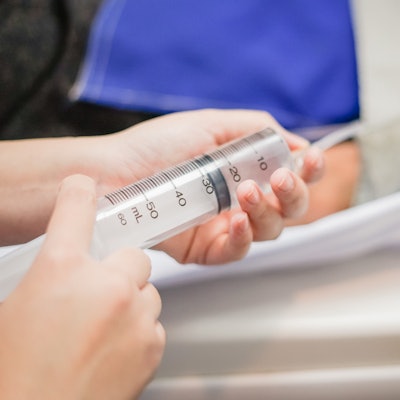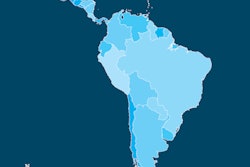
What's the best way for imaging facilities to manage the ongoing shortage of iodinated contrast media? In a May 26 webinar hosted by RSNA, a panel of radiology experts outlined the practical ways they are handling the shortage, describing strategies their institutions have implemented to respond.
Imaging facilities in the U.S. for the last several weeks have been grappling with shortages of iodinated contrast media, specifically the widely used Omnipaque (iohexol) agent from GE Healthcare. GE said that lockdowns at a manufacturing facility in Shanghai have interrupted Omnipaque shipments.
In the RSNA webinar, moderator Dr. Linda Moy of New York University Langone Health in New York City facilitated a discussion with key opinion leaders on strategies for dealing with the shortage.
Panelists included Dr. Andrew Bierhals of Mallinckrodt Institute of Radiology in St. Louis, MO; Dr. Elliot Fishman of Johns Hopkins in Baltimore; Dr. Mahmud Mossa-Basha of University of North Carolina in Chapel Hill; and Dr. Geoffrey Rubin of the University of Arizona and Banner University Medicine in Tucson. The group addressed a range of topics.
How severe is the shortage? Most panelists noted that the CT contrast shortage is affecting their institutions' facilities and hospitals differently.
"Banner Health runs 30 hospitals across four states and a large network of outpatient imaging practices," Rubin said. "We have a fairly diverse supply chain for contrast medium, but some of our facilities have felt the pinch while others have full inventory."
Mossa-Basha agreed: "Some institutions have a week of contrast in reserve, others a few weeks," he said. "GE says its production rates are improving, from 20% to 50%, and they project that in a few weeks they will be back at 100%. The situation is dynamic."
How can radiology coordinate contrast conservation? Rubin described a clinical consensus group that has been formed to assess and consolidate contrast inventory and to implement a tiered approach to the use of contrast. "The tiered approach [helps us assess] how aggressively to limit contrast-enhanced CT exams," he noted. The hospital has been exploring the use of 10-mL syringes for interventional procedures and has seen a 75% reduction in contrast, he said.
Bierhals described a weekly "huddle" held with different hospital service lines -- CT, interventional, cardiology, pain management -- to keep clinicians up to date on the current status of the contrast shortage. "We're talking to referring providers about the shortage and encouraging them to order alternative studies on the front end," he said.
Have imaging protocols changed? Yes, according to Mossa-Basha: His institution has shortened body and neuroradiology protocols and exams and created new workflows that suggest initial screening with noncontrast exams -- all in consultation with colleagues in other departments.
But providing patients the care they need is the overarching principle, Rubin cautioned. "We need to be vigilant to make sure we're not going too far [in decreasing contrast so that] insufficient contrast medium results in insufficient diagnostic exams," he said.
Fishman echoed this perspective: "We want to make sure [our colleagues] are comfortable that their patients are getting good quality of care, particularly in oncology," he said. "It's a balancing act that requires more work on our part."
Has reporting changed? The panelists agreed that the way they report imaging results has not changed and that they have not added any language about studies being conducted during a contrast shortage. "In terms of reporting, we've been trained a certain way, to report what we see, and if a study is limited and you have concerns, you communicate that," Mossa-Basha said. "You don't change your reporting style based on the shortage."
Has there been overreaction to the shortage? "Some of our clinicians have heard about the contrast shortage and have been ordering studies that really need contrast but ordering them without it," Fishman said. "The techs then have to call [and tell them] 'This needs IV contrast, and you have to order it.' We tell our techs, 'If you see something, say something -- don't do the study if it doesn't make sense.' "
Has there been pushback from patients or referring physicians? News outlets have tried to educate their readers about the contrast shortage, although these attempts have had varying success, according to Rubin. Yet the fact that the world has been dealing with supply chain issues during the COVID-19 pandemic has changed how patients see healthcare. "A lot of what we've gone through [in the past few years with] COVID and [personal protective equipment, PPE] and oxygen shortages have helped orient both medical staff and patients to lean times, so [this contrast shortage is] not the shock it might have been had this happened four or five years ago," he said.
Bierhals concurred. "I have not heard ... concerns from the patient perspective," he said. "[Our referring physicians] have been receptive [to education about the shortage]. We've prepped them about what to expect and what our limitations are and have developed more direct communication pathways to radiology to temper their concerns."
What if disruption is the new norm? "We need flexible, nimble systems to address equipment and supply challenges," Mossa-Basha said. "We need to diversify our suppliers and vendors and get a number of different options on the formulary -- which may be more expensive in the short term but protective in the long term," he said.
The CT contrast shortage is a wake-up call, according to Rubin. "Just because this is happening with contrast this time, [a supply shortage] might be completely different next time," he said. "Identify the key supplies that put your organization at highest risk and how inventory can impact [its] ability to function. We would be remiss if we're not asking the question of what's at most risk moving forward, and how we can protect [our resources] in the future."





















